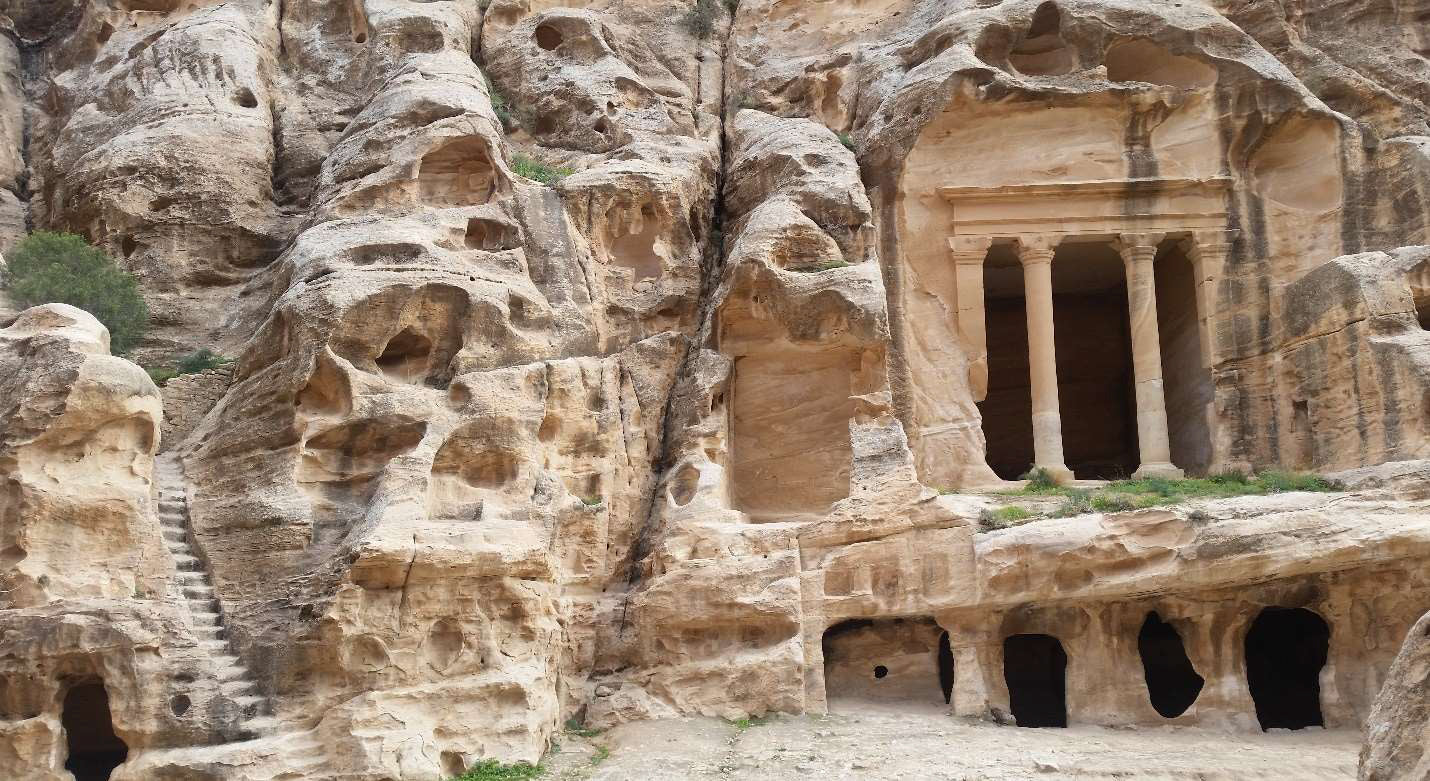
Trip Report: Jordan Trip 2019, Bulletin 3 by Todd Swain
Above: One of the facades carved into a sandstone cliff at Little Petra (note the stairs at left).
Our last bulletin was written in a hotel room in rainy and snowy Wadi Musa. Once the weather cleared, we went to nearby Petra, Little Petra and did a beautiful drive north from Petra to a Neolithic village site. The walking approach to Petra via the siq (slot canyon) is as impressive as any of the narrow canyons in Zion National Park in Utah. Generally 20-40 feet wide and hundreds of feet deep, it makes for a very awe-inspiring approach to the carved stone facades of Petra. Petra, a UNESCO World Heritage Site, is of course immensely popular, but despite the hordes of people, it’s still amazing and should be on everyone’s life list. The carved stone facades are mind-blowing when you think that they were done without power tools (imagine Mount Rushmore times 100, being done solely with stone and iron tools). Wow.
From Petra, we returned to Wadi Rum for six more days. We stayed five more nights out in Khaled’s desert camp and established three new routes on the wall directly above his camp. The routes went up this wonderful, varnished wall that looked like Swiss cheese. We spent over three weeks at Wadi Rum and could easily have spent three more.
We left Wadi Rum in a rainstorm (our timing was perfect) and headed north to the Dead Sea. In addition to bobbing in the sea, Donette smearing mud all over herself and being pampered by hotel staff, we also went climbing on a very fun limestone slab not far above the Dead Sea (but still well below sea level; the Dead Sea is about 1,440 feet below sea level [Badwater in Death Valley is 266 feet]). While there, we ran into a group of “youth at risk” that were being taken rock climbing as part of their intervention program. We talked at length with the Jordanian climbing guides about the program and that Donette had done the same work for Outward Bound.
 Above: Donette rappelling down the wall by Khaled’s camp where we did three new routes.
Above: Donette rappelling down the wall by Khaled’s camp where we did three new routes.
 Above: One of Jordanian teenagers giving Donette a drink and cookie at the Dead Sea slab.
Above: One of Jordanian teenagers giving Donette a drink and cookie at the Dead Sea slab.
From the Dead Sea, we headed a bit north to another World Heritage Site, the location of Christ’s baptism by the River Jordan. The site was quite interesting, in that the river is only about 25 yards wide and on the west bank (in Israel), it’s highly developed. On the Jordanian side, signs are posted prohibiting anyone from going in or near the water; on the Israeli side, lots of folks were in the water being baptized or re-baptized.
From the baptism site, we drove north up the Jordan River Valley, which became more and more verdant. We ended the day in Jerash, the site of an ancient Roman city that we toured the next day. Not too long ago, archaeologists at Jerash discovered what is the oldest known machine in the world – a water powered stone saw. The machine was built circa 550AD. As we were going to dinner in Jerash that first evening, we were stopped on the sidewalk by two Jordanian men, who very much wanted us to know that they were Muslims and good people. They emphasized that bad actors like members of ISIS were the tiny minority of Muslims and that they (and Jordan) loved America. This interaction was typical of our encounters in Jordan. Local residents would ask where we were from, say “Welcome to Jordan” and make some comment about liking America. This, despite the hardships they have endured from the wars in adjacent Iraq and Syria.
After Jerash, we continued to the very northwest corner of Jordan to another archaeological site, Umm Qays. The drive was beautiful – trees, hills covered in grass and copious wildflowers; so much so, that you could easily think you were in northern Italy or the Central Coast of California in spring. We really liked Umm Qays – it was a cool mash-up of Roman, Byzantine and Ottoman architecture where each successive group re-utilized building materials from the previous occupants. From the hilltop site, we had wonderful views of the Golan Heights and the Sea of Galilee. Both were a short distance away.
To get to our lodging for the night, we drove along the border with Jordan, Syria and Israel, passing through four military checkpoints and one police checkpoint. Everyone was friendly and our basic Arabic phrases of “hello” and “thank you” brought smiles to all the men manning the posts.
We had planned to climb at a few cliffs in northern Jordan with some local climbers, but the weather was rainy, so we headed back south to the Dead Sea for our last days in the field. On our previous trip to the Dead Sea slabs, we spied a great looking crack right off the road. One of the guides with the youth at risk group had told us the crack was unclimbed and encouraged us to go do it.
On the 30th, we went to the crack. I was about 2/3 of the way up when the police and a couple men from a nearby adventure center showed up. An adventure center guy told us it was illegal to climb on the cliff because of hiking fatalities that had occurred in the area in the past.

I was mid-route and Donette (while still belaying me) tried to explain the easiest thing to do was for me to get to the top so we could clean our gear. The adventure center guy said the army, more police and "the entire government" were on their way and would be there in five minutes to make sure we came down.
Donette then said we'd need to put an anchor in to get down and the adventure center guy said that was ok. Since I was mid-cliff, Donette explained an anchor on top would be better than one mid-face - less people would see it.
The guy doing all the talking said I was to put in an anchor where I was and come down immediately. So, I drilled an anchor and rappelled off, cleaning our gear from the crack. The rock was great, the crack pure and in the future, folks will wonder why the anchor is just below a ledge at 2/3 height.
We were then invited to tea at the adventure center, where we got to see the four sport routes they guide on. While it’s true that the terrible events they mentioned occurred, we're still unsure if there's actually a ban or if this is the adventure center protecting its turf. The police on scene left the talking to the adventure center guy and all was very amicable once I got down.
The next day we climbed a new route on the slabs near the Dead Sea and then went to a very impressive castle in the town of Kerak. From the Dead Sea we went out to the east of Amman, toward Iraq, to see the World Heritage Site of Qasr Amra. This and another nearby historic building were very cool and worth the drive. Both were apparently built along the ancient caravan route across the desert from the Mediterranean to Iraq and were in use roughly 1,000 years ago. It was then on to Amman, to turn in our rental car and visit the city.
 Above: The ancient structure at Qasr Amra, in the desert to the east of Amman.
Above: The ancient structure at Qasr Amra, in the desert to the east of Amman.
We did a day of sightseeing in Amman, visiting the Citadel, Roman Theatre, Museums of Folklore and Traditions and the Blue Mosque (reportedly the only mosque in the city that non- Muslims can enter).
Our six-week trip to Jordan was hugely memorable. We will always cherish our time with Khaled and his family, climbing with friends far out in the desert and interacting with the wonderfully friendly people of Jordan.
 Above: Camels grazing at Wadi Rum.
Above: Camels grazing at Wadi Rum.
 Above: With Khaled at Wadi Rum.
Above: With Khaled at Wadi Rum.
